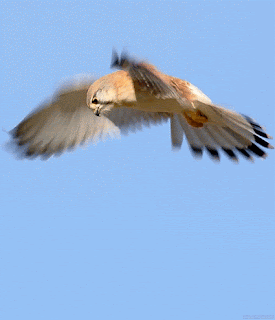 |
| You have probably seen these birds hovering over a hapless field-mouse as the raptor pinpoints its precise location before plunging in to harvest his lunch. |
 |
| Range map. Green is present year-round. Amber is spring-summer-fall range. |
Kestrels, also known as Sparrow Hawks, are North America's smallest falcon. Some experts estimate that populations of the American Kestrel has plummeted by over 90% over the last fifty years.
The very high populations of fifty to one-hundred-fifty years ago were almost certainly a historical anomaly.
Among the probable "players" for the decline are loss of nesting habitat, disease and parasites, and loss of prime, foraging habitat.
Kestrels, along with several species of small owls, are cavity nesters. When there are not enough suitable sites available, continuous use results in a build-up of lice, ticks, nesting material, poor drainage and diseases. There are tons of plans for "Kestrel nesting boxes" on the internet.
The loss of prime foraging habitat is a tougher nut to crack. Farmers almost always had pasture and that pasture always had a stair-step progression of grass in terms of height. It was heaven for mice and easy for avian foragers to hunt.
Those small farms also made grain, used to feed livestock, available to English Sparrows. To a kestrel, a colony of English Sparrows is the equivalent of a drive-through window at a KFC.
Finally, those old farms seethed with insect life. The weight of the beetles, grubs and hossgrappers on an acre of pasture could easily outweigh the cow that was grazing it.
All of those components; rodents, birds and bugs are key elements of the American Kestrel's diet and suburban America with its manicured lawns, prodigious use of pesticides and poverty of grain-eating livestock contribute to that. Even commonplace technologies like power garage-doors contribute to the decline by trapping kestrels. The high-strung birds are likely to injure themselves in their frenzy to escape by smashing through windows.
None of the conditions listed above were common in most of pre-Columbian America.
Hat-tip to Lucas Machias for the idea for this post.
ERJ, what an interesting post.
ReplyDeleteI do think the destruction of old farms is an interesting thought. Sadly, we seem intent on destroying them as quickly as possible.
Rodent killing poison baits are claimed to be a pressure on them as well.
ReplyDeleteA more recent threat to many of these classes of birds is the spread of windmills across much of their hunting territory. For a so-called "green" electricity generating solution, windmills are hugely destructive of a lot of flying wildlife - insects, bats, birds etc.
ReplyDeleteThere is hope, I saw a breeding pair in Phoenix a few years ago. One of them may have been trained and then escaped, because they were dining on pigeon. Those feathered rats abound in Phoenix, so the kestrels would never go hungry.
ReplyDeleteWe don't see many sparrowhawks around here , a fair number of Merlins though (a falcon between a Kestrel and a Peregrine in size). I have watched them chase a squirrel around a tree trunk up and down and around and around- and had to rescue one after she knocked herself silly flying into a window.
ReplyDeleteSmall fields, easily plowed by mule or ox, had hedgerows. A patchwork of small fields were rotated to fallow in turn. Paradise for the little birds and hedgehogs and all the other critters. Truly beneficial diversity.
ReplyDeleteIsaiah 5:8
Woe unto them that join house to house, that lay field to field, till there be no place, that they may be placed alone in the midst of the earth!
Micah 4:4
But they shall sit every man under his vine and under his fig tree; and none shall make them afraid: for the mouth of the Lord of hosts hath spoken it.
Interesting how the fortune or misery of mankind is coupled to trees....you have them, it is well with you, appreciate the blessing...mess up, your trees are taken and you suffer....and the future when sin is conquered and removed, features trees, on earth and even in Eternal Jerusalem, which is placed upon a newly created Earth. Do a word study of Scripture on trees, beginning with the first two, and the last ones mentioned, and consider the blood drenched tree in between that bought the final blessing.
You can add Deut 20:19-20 to that list.
DeleteWhen you are at war with a city and have to lay siege to it for a long time before you capture it, you shall not destroy its trees by putting an ax to them. You may eat of them, but you must not cut them down. Are the trees of the field human beings, that they should be included in your siege?
However, those trees which you know are not fruit trees you may destroy. You may cut them down to build siegeworks against the city that is waging war with you, until it falls.
Another reason the Middle East is so desolate is the Ottoman Empire levied land tax based on the amount of trees on properties. Landowners had incentive to lay waste to the region. Add in the Arabs and their strip grazing habits and general disregard for decency and prudence, all this on top of the scorched earth warfare, and we have the wastelands of today. At the root of it all........sin.
DeleteStefan v.